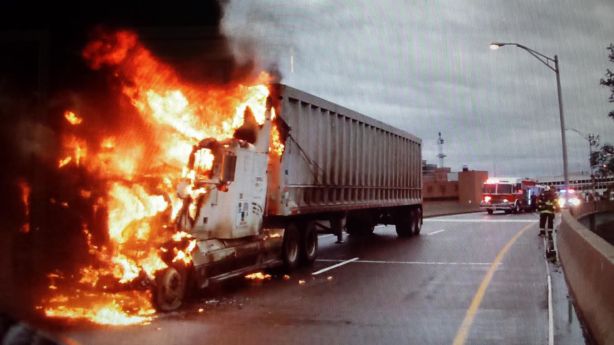 By Brian Butler
By Brian Butler
“Engine 4 is on location, we have a vehicle fully involved, pulling a line.” It’s not really a thorough “size up” but more of a brief radio report of what you got and what you’re doing. It’s simple, short, and to the point. But after that report, we should perform a more thorough mental size up when dealing with automobiles and moving machinery. This includes ensuring proper apparatus placement, traffic control, proper line selection and proactive awareness of the typical dangers such as launching struts, burning magnesium, numerous airbags (inflators), plastic fuel tanks and running fuel fires (which is why proper apparatus placement is so important). See our vehicle fires page for more.
These on-approach size ups should be done by everyone on board, not just the company officer. The pump operator, nozzleman and officer ALL NEED to size up vehicles involved in fires, accidents or both for various reasons. (Most vehicle fires send one engine to handle the job. Some departments may attach a truck, squad, or rescue company).
A mental size up just means it’s not being announced on the radio, but you’re still analyzing what’s in front of you. Most radio reports should be kept brief unless it’s a major incident involving a target hazard vehicle like an occupied school bus with entrapment, or a gasoline tanker which would require additional resources, shutting down highways etc..
Add a fire to this incident. What’s your plan with a 3-man engine company?
TARGET HAZARD VEHICLES: There are some vehicles I label “target hazard” vehicles. They’re types of vehicles and moving machinery that have the potential to further complicate the incident when they’re involved in an accident, fire, or both.
The term “moving machinery” is broad and defined as any machine in motion on our roads and highways. Trailers hauling numerous vehicles, landscaping trailers with agriculture-lawn mowers, gasoline on-board, wood chipper trailers, sanitation trucks with (roll off) compactors, large construction vehicles on trailers, wide load vehicle transports, and other large machinery being hauled that may become unstable or add additional fuel to the fire. Simply put, it’s the shit you worry about when you arrive on scene and realize you do not have the manpower or equipment to handle the incident. Then Murphy shows up and gives you a rapid rescue that needs to take place.
The definition of a “target hazard” vehicle is simple; it’s any vehicle that when involved in an accident or fire, SHOULD raise a red flag. Some examples are:
-CNG Transit Bus
-School Bus
-RV’s, Food Trucks (Propane)
-Sanitation Trucks (Garbage, Recycling)
-Hazmat Delivery Trucks (Fuel Delivery, Propane, Gasoline Tanker)
-Cement Trucks
-Ambulances
-Armored Trucks
When these types of transportation machinery are involved in fires or accidents, use extreme caution and properly size up all vehicles involved before taking any action.
Urban Fire Training offers an advanced class on transportation machinery. This is a valuable class and the only one out there on sizing up moving transportation machinery.
Schedule a class for your department by emailing urbanfiretraining@gmail.com.
ELEVATORS, TRAINS, and AUTOMOBILES: Sizing up Transportation and Passenger Occupied Machinery.